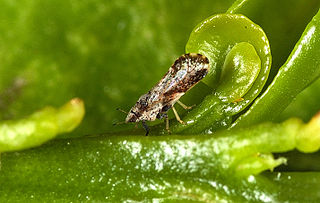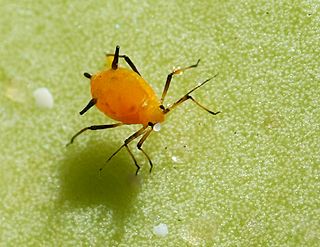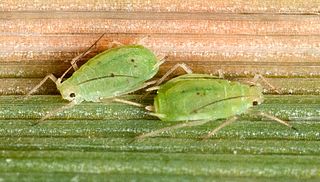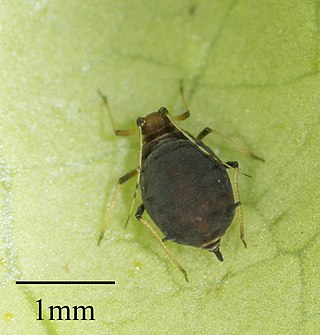
Aphids are small sap-sucking insects and members of the superfamily Aphidoidea. Common names include greenfly and blackfly, although individuals within a species can vary widely in color. The group includes the fluffy white woolly aphids. A typical life cycle involves flightless females giving live birth to female nymphs—who may also be already pregnant, an adaptation scientists call telescoping generations—without the involvement of males. Maturing rapidly, females breed profusely so that the number of these insects multiplies quickly. Winged females may develop later in the season, allowing the insects to colonize new plants. In temperate regions, a phase of sexual reproduction occurs in the autumn, with the insects often overwintering as eggs.

The Aphididae are a very large insect family in the aphid superfamily (Aphidoidea), of the order Hemiptera. These insects suck the sap from plant leaves. Several thousand species are placed in this family, many of which are considered plant/crop pests. They are the family of insects containing most plant virus vectors with the green peach aphid being one of the most prevalent and indiscriminate carriers.

The silverleaf whitefly is one of several species of whitefly that are currently important agricultural pests. A review in 2011 concluded that the silverleaf whitefly is actually a species complex containing at least 40 morphologically indistinguishable species.

The Russian wheat aphid is an aphid that can cause significant losses in cereal crops. The species was introduced to the United States in 1986 and is considered an invasive species there. This aphid is pale green and up to 2 mm long. Cornicles are very short, rounded, and appear to be lacking. There is an appendage above the cauda giving the aphid the appearance of having two tails. The saliva of this aphid is toxic to the plant and causes whitish striping on cereal leaves. Feeding by this aphid will also cause the flag leaf to turn white and curl around the head causing incomplete head emergence. Its host plants are cereal grain crops including wheat and barley and to a lesser extent, wild grasses such as wheatgrasses, brome-grasses, ryegrasses and anything in the grass family.
Citrus tristeza virus (CTV) is a viral species of the genus Closterovirus that causes the most economically damaging disease to its namesake plant genus, Citrus. The disease has led to the death of millions of Citrus trees all over the world and has rendered millions of others useless for production. Farmers in Brazil and other South American countries gave it the name "tristeza", meaning sadness in Portuguese and Spanish, referring to the devastation produced by the disease in the 1930s. The virus is transmitted most efficiently by the brown citrus aphid.

The soybean aphid is an insect pest of soybean that is exotic to North America. The soybean aphid is native to Asia. It has been described as a common pest of soybeans in China and as an occasional pest of soybeans in Indonesia, Japan, Korea, Malaysia, the Philippines, and Thailand. The soybean aphid was first documented in North America in Wisconsin in July 2000. Ragsdale et al. (2004) noted that the soybean aphid probably arrived in North America earlier than 2000, but remained undetected for a period of time. Venette and Ragsdale (2004) suggested that Japan probably served as the point of origin for the soybean aphid's North American invasion. By 2003, the soybean aphid had been documented in Delaware, Georgia, Illinois, Indiana, Iowa, Kansas, Kentucky, Michigan, Minnesota, Mississippi, Missouri, Nebraska, New York, North Dakota, Ohio, Pennsylvania, South Dakota, Virginia, West Virginia, and Wisconsin. Together, these states accounted for 89% of the 63,600,000 acres (257,000 km2) of soybean planted in the United States in 2007.

Myzus persicae, known as the green peach aphid, greenfly, or the peach-potato aphid, is a small green aphid belonging to the order Hemiptera. It is the most significant aphid pest of peach trees, causing decreased growth, shrivelling of the leaves and the death of various tissues. It also acts as a vector for the transport of plant viruses such as cucumber mosaic virus (CMV), potato virus Y (PVY) and tobacco etch virus (TEV). Potato virus Y and potato leafroll virus can be passed to members of the nightshade/potato family (Solanaceae), and various mosaic viruses to many other food crops.

Aphis gossypii is a tiny insect, an aphid ("greenfly") in the superfamily Aphidoidea in the order Hemiptera. It is a true bug and sucks sap from plants. It is a widely distributed pest of a variety of agricultural crops in the families Cucurbitaceae, Rutaceae and Malvaceae. Common names include cotton aphid, melon aphid and melon and cotton aphid.

Aleurocanthus woglumi is a species of whitefly in the family Aleyrodidae. It is a pest of citrus crops, and is commonly known as the citrus blackfly because of its slate-blue colour. It originated in Asia, but has spread to other parts of the world. The parasitic wasps, Encarsia perplexa and Amitus hesperidum can help control the pest.

Diaphorina citri, the Asian citrus psyllid, is a sap-sucking, hemipteran bug in the family Psyllidae. It is one of two confirmed vectors of citrus greening disease. It has a wide distribution in southern Asia and has spread to other citrus growing regions.

Macrosiphum euphorbiae, the potato aphid, is a sap-sucking pest insect in the family Aphididae. It infests potatoes and a number of other commercially important crops.

Rhopalosiphum maidis, common names corn leaf aphid and corn aphid, is an insect, and a pest of maize and other crops. It has a nearly worldwide distribution and is typically found in agricultural fields, grasslands, and forest-grassland zones. Among aphids that feed on maize, it is the most commonly encountered and most economically damaging, particularly in tropical and warmer temperate areas. In addition to maize, R. maidis damages rice, sorghum, and other cultivated and wild monocots.

Phylloxeridae is a small family of plant-parasitic hemipterans closely related to aphids with only 75 described species. This group comprises two subfamilies and 11 genera with one that is fossil. The genus type is Phylloxera. The Phylloxeridae species are usually called phylloxerans or phylloxerids.

Aphis craccivora, variously known as the cowpea aphid, groundnut aphid or black legume aphid, is a true bug in the family Aphididae. Originally of probable Palearctic origin, it is now an invasive species of cosmopolitan distribution.

Aphis nerii is an aphid of the family Aphididae. Its common names include oleander aphid, milkweed aphid, sweet pepper aphid, and nerium aphid.

Aphis spiraecola is a species of aphid described in 1914 by Edith Marion Patch. Its common names include green citrus aphid, Spirea aphid, and apple aphid. It is distributed worldwide, and is most abundant in the United States. It has a diploid chromosome number of 2n=8.

Bird cherry-oat aphid is an aphid in the superfamily Aphidoidea in the order Hemiptera. It is a true bug and sucks sap from plants. It is considered a major pest in cereal crops, especially in temperate regions, as well as other hosts in parts of Northern Europe. It is the principal vector of many viruses in economically important field crops.

Rhopalosiphum rufiabdominale, the rice root aphid or red rice root aphid, is a sap-sucking insect pest with a wide host range and a global distribution. As a member of the superfamily Aphidoidea, it is one of 16 species of the genus Rhopalosiphum. Adults and nymphs are soft-bodied and usually dark green with brown, red, or yellow tones. Like all aphids, reproduction is sexual and asexual, depending on the environmental conditions and host plant. Rice root aphids cause injury to external plant parts, namely the roots or stem, by feeding on plant sap and vector several important plant viruses. The hosts of this pest extend across multiple plant families with most belonging to Rosaceae, Poaceae, and Solanaceae. R. rufiabdominale is universally associated with Prunus species but also infests various field crops, greenhouse vegetables, cannabis, and other ornamental plants. While this aphid originates from east Asia, it spans nearly every continent. Dispersal is particularly widespread across the United States, India, and Australia, with crop damage documented in multiple instances, although economic losses are primarily associated with Japanese rice crops. Nonetheless, it remains a pest of serious concern due to its high mobility, discrete habitat, and adaptive plasticity, giving it the rightful reputation as a successful invader.

The greenbug, or wheat aphid, is an aphid in the superfamily Aphidoidea in the order Hemiptera. It is a true bug and feeds on the leaves of Gramineae (grass) family members.

The Brown Citrus Aphid,, is an aphid in the superfamily Aphidoidea in the order Hemiptera. It is a true bug and sucks sap from plants. It is known to hosts in well over 150+ plant species.


















